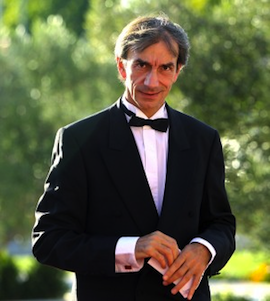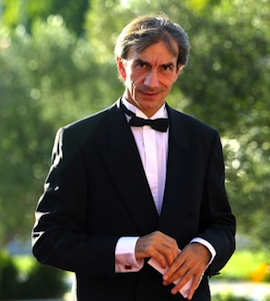
For the long-suffering patrons of the Santa Rosa Symphony, the acoustics at the new Green Music Center have come as a true revelation. To be fair, the Symphony’s former venue — the Wells Fargo Center — was never intended as a concert hall. It began life as a New Age church, complete with low ceilings, wall-to-wall carpeting, and a sound system designed for uplifting sermons and Christian rock. To hear the Symphony play there was like observing it at the bottom of an elevator shaft and contenting yourself with whatever sounds managed to reach your ears.
In delightful contrast, the acoustics at the GMC bring every orchestral peep and bow stroke straight to your auditory canal, where they burst into flavor, like fine wine on your palate. Under these new circumstances, the Symphony — which sounded pretty good even at the Wells Fargo — is revealed to be a truly wonderful local orchestra, with some standout players who would be right at home in major-league ensembles in New York, Chicago, or San Francisco.
Just how good is the Santa Rosa band? Judging from its all-French program Saturday at the GMC, the answer is fantastique. Whether it can approach its San Francisco cousins in talent will be a matter of much debate when the latter ensemble travels to the GMC next month. In the meantime, North Bay music lovers can revel in their orchestra’s newfound sonic brilliance.
That brilliance was on particular display in the third movement of Berlioz’s Symphonie Fantastique, the concluding piece on a program that also embraced works by Saint-Saëns and the contemporary composer Martin Matalon. The movement began with a gorgeous duet between English hornist Bennie Cottone and off-stage oboist Laura Reynolds. The sound of each instrument was crystalline, floating through the air like the cooings of a pair of mourning doves. The orchestral accompaniment, when it arrived, was by turns a babbling brook or a raging torrent, with the dynamics and velocity pirouetting at a moment’s notice. The ensuing clarinet solo by Roy Zajac was elegant, and the concluding dialogue between English horn and timpani was mesmerizing.
From start to finish, the performance of Symphonie Fantastique was an object lesson is orchestral expressivity. Music Director Bruno Ferrandis, restraining himself to a podium that seems much too small for his dancelike gestures, was in perpetual motion, producing strong dynamic contrasts throughout Berlioz’ masterpiece. The beginning was hushed, with great sound from the basses. The inevitable crescendo was both energetic and shapely, culminating in a convincing display of orchestral might, particularly from the violins.
From start to finish, the performance of Symphonie Fantastique was an object lesson is orchestral expressivity.
The second-movement waltz was fresh as well as lilting, with brisk tempos and fully engaged players. The clarinet duet near the end was especially charming, leading to a smattering of applause. After the gorgeous middle movement, the fourth and fifth movements made for a long cascade of increasingly dense and frantic sound. The famous “march to the scaffold” in the fourth was marked by strong contrasts and quickening tempo. The fifth, with its bass drums, orchestral bells, and relentless “Dies Irae” theme, was a headlong rush to ecstasy. Every section of the orchestra sounded terrific, nowhere more so than when the strings suddenly began playing col legno, hitting their instruments with their bows. It was a signature moment in an inspired performance.
Bring Out the Brass
The performances in the first half were likewise inspired, even if the music was not. The evening began with Martin Matalon’s De tiempo y de metal (Of time and of metal), which premiered in 2010 at the Abbey of Noirlac in France. Matalon, an Argentine who lives in Paris, conceived the piece, which is scored for a dozen brass instruments, as a kind of homage to the antiphonal works that Gabrieli and other 16th-century composers wrote for St. Mark’s in Venice. Indeed, the Santa Rosa musicians prefaced their performance with a quick spin through Gabrieli’s Song for First Tones, dated 1597.
The players were arranged on the stage somewhat antiphonally, with a pair of trumpets on each side, four French horns clustered in the middle, and three trombones and a tuba dispersed betwixt and between. The piece began quietly, with muted fast runs from the trumpets punctuated by occasional blats from the tuba. There seemed to be as much silence as sound, yet the silences were filled with the hypnotic stroke of Ferrandis’ baton, which kept a steady beat throughout.
Collard proved himself capable of playing any notes Saint-Saëns threw his way … and seemed to grow stronger as the concerto wore on.
De tiempo y de metal lived up to its title, with both a strong temporal element and an inventive exploration of the sounds made by metal instruments, from rushing wind to full-throated roar. The ending was effective, as were certain sections, but the piece mostly sounded academic, more concerned with cataloging possibilities than harnessing them to something larger.
Similar problems afflicted the Piano Concerto No. 2 by Camille Saint-Saëns, ably performed by Jean-Philippe Collard. Saint-Saëns suffered from an excess of facility, the notes pouring from his pen in an unending stream of Romantic abandon. His second piano concerto, the only one performed with any regularity, features a captivating scherzo in the middle, but the outer movements are a continuous blur of notes without any definite direction, an overwhelming sauce that drowns the dinner beneath.
Collard proved himself capable of playing any notes Saint-Saëns threw his way, from the resonant bass chords at the beginning of the first movement, to the many descending cascades in the middle and to the long cadenza at the end. He used lots of pedal and made a prodigious sound, more than matching the orchestra in volume. He seemed to grow stronger as the concerto wore on, building up some genuine excitement in the concluding movement, but in the end Saint-Saëns lies beneath his talent. A better concerto would have made a good concert great.

